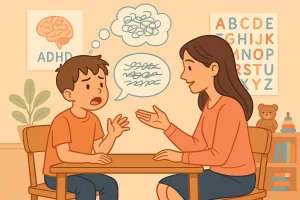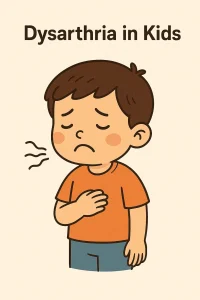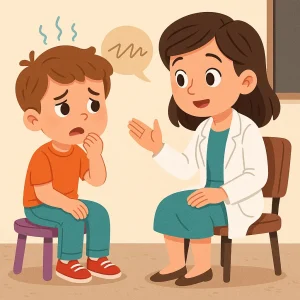Stuttering: Disorder or Disability? What You Need to Know
Last Updated: August 1, 2024
Stuttering is more than just a speech impediment; it affects how individuals communicate and interact with the world around them. For some, stuttering is a mild inconvenience, while for others, it can significantly impact their daily lives. This variability raises an important question: Is stuttering a disorder or a disability? Understanding this distinction is crucial, as it shapes how we view and support those who stutter.
Understanding Stuttering
Stuttering, also known as stammering, is a speech disorder characterized by disruptions in the flow of speech. These disruptions, known as disfluencies, can take many forms, including repetitions of sounds, syllables, or words, prolonged sounds, and involuntary pauses or blocks in speech. For individuals who stutter, these symptoms can vary in frequency and severity, often fluctuating in different situations and over time.
Common symptoms of stuttering include:
- Repetitions: Repeating sounds, syllables, or words (e.g., “w-w-w-where”).
- Prolongations: Holding a sound for an extended period (e.g., “sssssometimes”).
- Blocks: Pauses or stops in speech where the individual is unable to produce any sound.
These symptoms can manifest in daily life in various ways. For instance, a person might struggle to say their name during an introduction, experience difficulty ordering food at a restaurant, or feel anxious about speaking on the phone. These challenges can impact self-esteem, social interactions, and professional opportunities.
Also read: What is Stuttering: Types, Symptoms, and Causes
Stuttering as a Disorder
From a medical perspective, stuttering is classified as a speech disorder. This classification is based on the disruptions in speech fluency that stuttering causes, which can interfere with effective communication. As a speech disorder, stuttering involves repetitive sounds, prolongations, and blocks that make it challenging for individuals to speak smoothly.
Also read: Is There a Link Between Stuttering and Tourette’s Syndrome?
Causes and Contributing Factors
Stuttering is a complex condition with multiple contributing factors. Understanding these causes can help in managing and treating the disorder effectively. Some of the primary causes and factors include:
- Genetics: Research indicates that stuttering often runs in families, suggesting a genetic component. If a close family member stutters, there is an increased likelihood that other members may also develop the condition.
- Neurological Factors: Differences in the brain’s processing of speech and language have been linked to stuttering. These neurological differences can affect how speech signals are coordinated and executed.
- Developmental Factors: Stuttering often begins in early childhood when speech and language skills are rapidly developing. During this period, the demands on a child’s speech and language abilities can contribute to the onset of stuttering.
- Environmental Factors: Stressful environments, rapid changes in a child’s surroundings, or high expectations for speech performance can exacerbate stuttering.
Causes and Contributing Factors of Stuttering
| Causes | Description |
|---|---|
| Genetics | Family history of stuttering increases the likelihood of developing it. Research suggests that stuttering can be inherited and may run in families. |
| Neurological Factors | Differences in brain processing of speech and language. Studies show that individuals who stutter may have atypical brain activity related to speech production. |
| Developmental Factors | Stuttering often begins in early childhood during rapid speech development. Children who are developing their speech and language skills might stutter temporarily, but persistent stuttering can continue into adulthood. |
| Environmental Factors | Stressful environments or high expectations can exacerbate stuttering. Situational stressors such as pressure to speak fluently, anxiety, or changes in routine can worsen stuttering symptoms. |
Also read: Adult Stuttering: Causes, Treatment & Living Well
Common Treatments and Therapies
Managing stuttering typically involves a combination of treatments and therapies designed to improve speech fluency and reduce the impact of stuttering on daily life. Some of the common treatments include:
- Speech Therapy: Working with a speech-language pathologist (SLP) can help individuals learn techniques to improve their speech fluency. This may include strategies for controlling speech rate, using gentle onset of speech, and practicing fluent speech patterns.
- Cognitive Behavioral Therapy (CBT): CBT can help address the anxiety and negative emotions associated with stuttering. By changing negative thought patterns, individuals can reduce the psychological impact of stuttering.
- Electronic Devices: Some electronic devices can help improve speech fluency by providing auditory feedback that helps individuals control their speech patterns.
- Support Groups: Joining support groups allows individuals who stutter to share their experiences, learn from others, and gain emotional support.
Common Treatments and Therapies for Stuttering
| Treatment/Therapy | Description |
|---|---|
| Speech Therapy | Techniques to improve speech fluency, such as controlled fluency, gentle onsets, and pausing. Speech therapists work one-on-one to develop personalized strategies. |
| Cognitive Behavioral Therapy | Helps address anxiety and negative emotions associated with stuttering. CBT focuses on changing negative thought patterns and reducing speech-related stress. |
| Electronic Devices | Provides auditory feedback to help control speech patterns. Devices like delayed auditory feedback (DAF) or frequency-altered feedback (FAF) can help reduce stuttering episodes. |
| Support Groups | Offers emotional support and practical advice from others who stutter. Being part of a community helps individuals share experiences, learn coping strategies, and gain confidence. |
Read more: Neurogenic Stuttering vs Psychogenic Stuttering: Key Differences Explained
Stuttering as a Disability
Under various legal frameworks, a disability is generally defined as a physical or mental impairment that substantially limits one or more major life activities. This definition encompasses a wide range of conditions, including speech disabilities like stuttering. In many countries, including the UK and the US, laws such as the Equality Act and the Americans with Disabilities Act (ADA) provide protections and support for individuals with disabilities.
How Stuttering Can Be Classified as a Disability
Stuttering can be classified as a disability when it significantly impacts a person’s ability to perform everyday activities. For instance, if stuttering affects one’s ability to communicate effectively in daily interactions, it can be considered a substantial limitation. This classification is important because it ensures that individuals who stutter are entitled to protections against discrimination and can access necessary accommodations.
Examples of Situations Where Stuttering is Considered a Disability
There are several scenarios where stuttering is recognized as a disability:
- Job Interviews: An individual who stutters may face difficulties during job interviews, such as being unable to articulate responses smoothly. This can be particularly challenging in high-stress environments, where fluency issues may be more pronounced.
- Academic Settings: In schools or universities, students who stutter might struggle with oral presentations or participating in class discussions. These challenges can affect their academic performance and participation.
- Workplace Communication: Employees who stutter may find it hard to communicate effectively during meetings, phone calls, or presentations. This can impact their job performance and interactions with colleagues.
In these situations, stuttering is not just a minor inconvenience but a significant barrier to effective communication and participation. Recognizing stuttering as a disability ensures that individuals receive appropriate support and accommodations, such as extra time for presentations, alternative communication methods, or speech therapy services.
Know more: Helping Your Child Overcome Stuttering: A Guide for Parents
Legal Protections and Rights
For individuals who stutter, legal protections against discrimination are crucial in ensuring equal opportunities and fair treatment. These protections are often provided under various laws and regulations designed to prevent discrimination based on disabilities. One common question is: Is stuttering considered a disorder? Understanding this helps clarify the legal rights of those who stutter.
The Importance of the Equality Act and Other Relevant Laws
In many countries, including the UK, the Equality Act provides comprehensive protections for individuals with disabilities. Under the Equality Act, stuttering is recognized as a disability if it has a substantial and long-term adverse effect on a person’s ability to carry out normal day-to-day activities. This legal framework helps protect individuals from discrimination in various settings, such as employment, education, and access to services.
Similarly, in the United States, the Americans with Disabilities Act (ADA) ensures that individuals with stuttering are protected against discrimination. The ADA defines disability in a way that includes stuttering, provided it substantially limits one or more major life activities.
Obtaining Reasonable Adjustments
To support individuals who stutter, it is essential to provide reasonable adjustments in different environments. These adjustments are modifications or accommodations that help mitigate the challenges associated with stuttering and promote inclusivity.
Steps to Obtain Reasonable Adjustments:
- Identify Needs: Determine the specific challenges faced due to stuttering. This could include difficulties in communication during meetings, presentations, or phone calls.
- Request Adjustments: Approach your employer, school, or service provider to discuss the needed accommodations. Examples of reasonable adjustments include:
- Extra time for oral presentations or exams.
- The option to provide written responses instead of verbal ones.
- Use of communication aids or software that assists with speech.
- Provide Documentation: In some cases, you might need to provide medical documentation or an assessment from a speech-language pathologist to support your request.
- Negotiate and Implement: Work collaboratively with the organization to implement the adjustments. This might involve trial periods to see what works best.
- Seek Support: If an organization is reluctant to provide reasonable adjustments, seek advice from legal advisors or advocacy groups specializing in disability rights.
Practical Examples of Reasonable Adjustments:
- At Work: Allowing an employee who stutters to use email instead of phone calls for communication, providing additional time for tasks that require verbal interaction, or offering speech therapy support.
- In Education: Allowing students extra time for oral exams, offering alternative assessment methods, or providing a supportive environment where stuttering is understood and accommodated.
Managing Stuttering
Managing stuttering effectively can significantly improve the quality of life for those who stutter. Here are some practical tips and strategies to help manage stuttering in daily life:
Practical Tips for Managing Stuttering
- Practice Mindful Breathing: Focused breathing exercises can help control the rhythm of speech. Try inhaling deeply before speaking and maintaining a steady breathing pattern while talking.
- Slow Down: Speak at a slower pace to reduce the likelihood of stuttering. Pausing between words or phrases can give you more control over your speech.
- Use Gentle Onsets: Start words gently and softly to ease into speaking. This technique helps reduce the tension that often triggers stuttering.
- Self-Monitoring: Keep track of when and where you stutter. Understanding patterns can help you identify specific situations that may trigger stuttering and prepare for them.
- Visualization Techniques: Visualize speaking smoothly and confidently. Positive visualization can reduce anxiety and improve speech fluency.
- Avoid Avoidance: Instead of avoiding difficult words or situations, practice facing them gradually. This builds confidence and reduces the fear associated with stuttering.
Seeking Support from Speech Therapists and Support Groups
Professional help can make a significant difference in managing stuttering:
- Speech Therapists: Working with a speech therapist can provide tailored strategies to improve speech fluency. They can teach techniques such as controlled fluency, which involves monitoring and adjusting speech patterns to reduce stuttering.
- Support Groups: Joining a support group can offer emotional support and practical advice from others who stutter. Sharing experiences and coping strategies in a supportive environment can be very empowering.
Assistive Technologies and Tools
Various assistive technologies can also aid in managing stuttering:
- Speech Apps: Several apps are designed to help people who stutter by providing exercises and feedback to improve fluency.
- Delayed Auditory Feedback (DAF) Devices: These devices play back the speaker’s voice with a slight delay, which can help reduce stuttering by altering the auditory feedback loop.
- Electronic Fluency Devices: These portable devices provide real-time feedback and can help improve speech fluency during conversations.
Personal Perspectives and Experiences
Stories and Testimonials
Understanding stuttering from a personal perspective can provide valuable insights into the diverse experiences of those who stutter. Here are some stories from individuals who have navigated the challenges and triumphs associated with stuttering:
- John’s Journey: “Growing up, I always felt anxious about speaking in class. My stuttering made it hard for me to participate, and I often felt isolated. It wasn’t until I joined a support group and met others who stutter that I began to see my stutter as just a part of who I am, rather than a flaw. Through speech therapy and support from my peers, I’ve learned techniques to manage my stuttering and have gained confidence in my communication skills.”
- Sarah’s Success: “For me, stuttering has always been a part of my life. In my career as a teacher, I’ve faced many challenges, but I’ve also found ways to adapt. My school has been very supportive, providing me with tools and accommodations that help me in the classroom. I’ve come to see my stuttering not as a disability, but as a unique aspect of my identity that I can embrace.”
The Debate: Disability vs. Difference
Within the stuttering community, there is an ongoing debate about whether stuttering should be viewed as a disability or simply a difference. This discussion is crucial in shaping how society understands and supports those who stutter.
Viewing Stuttering as a Disability:
- Legal Protections: Recognizing stuttering as a disability ensures that individuals receive legal protections and accommodations under laws like the Equality Act and the Americans with Disabilities Act. These protections are vital for preventing discrimination and ensuring equal opportunities in various settings, such as employment and education.
- Support and Resources: Classifying stuttering as a disability can also help individuals access necessary resources and support services, such as speech therapy and assistive technologies, that can improve their quality of life.
Viewing Stuttering as a Difference:
- Acceptance and Inclusivity: Some members of the stuttering community advocate for viewing stuttering as a difference rather than a disability. This perspective emphasizes the importance of acceptance and inclusivity, encouraging society to embrace diverse ways of speaking and communicating.
- Empowerment: By framing stuttering as a difference, individuals can feel empowered to express themselves authentically without feeling pressured to conform to traditional standards of speech fluency.
Conclusion
In this article, we’ve explored the complexities of stuttering, looking at whether it is a disorder or a disability and understanding its impact on people’s lives. We’ve discussed the medical perspective, legal definitions and protections, and practical strategies for managing stuttering day-to-day. We’ve also shared personal stories to highlight the varied experiences within the stuttering community.
It’s important to recognize that stuttering can affect communication and quality of life. Providing support and understanding is key. This means offering the right accommodations, creating inclusive environments, and accepting different ways of speaking. If you or someone you know stutters, seek help from speech therapists, join support groups, and use assistive technologies. At Wellness Hub, we’re here to support you with resources, therapy options, and a community that understands. For more information, visit our speech therapy page and explore our resources to find the support you need.
Frequently Asked Questions:
1. What is stuttering?
Stuttering is a speech disorder characterized by disruptions in the flow of speech, such as repetitions, prolongations, and blocks. These disruptions can affect communication and daily activities.
2. Is stuttering a disorder or a disability?
Stuttering can be both a disorder and a disability. Medically, it is classified as a speech disorder. Legally, it can be considered a disability if it significantly impacts a person’s ability to perform everyday activities.
3. What causes stuttering in adults?
The causes of stuttering can include genetic factors, neurological differences, developmental factors, and environmental influences. Each person’s experience with stuttering can vary.
4. How can stuttering be treated?
Stuttering can be managed with speech therapy, cognitive-behavioral therapy, and assistive technologies. Speech therapists can provide techniques to improve fluency and communication skills.
5. Can stuttering be classified as a disability?
Yes, stuttering can be classified as a disability if it substantially limits one or more major life activities. Legal protections under acts like the Equality Act and the Americans with Disabilities Act ensure that individuals who stutter are not discriminated against.
6. What are reasonable adjustments for stuttering in the workplace?
Reasonable adjustments may include additional time for oral presentations, allowing written communication instead of phone calls, and using communication aids. These accommodations help individuals manage their stuttering effectively.
7. How can I support someone who stutters?
Support can include being patient, listening attentively, and avoiding finishing their sentences. Encouraging them to seek professional help and joining support groups can also be beneficial.
8. Are there support groups for people who stutter?
Yes, there are many support groups for people who stutter. These groups provide a safe space to share experiences, gain emotional support, and learn practical strategies for managing stuttering.
9. What is the difference between a stuttering disorder and a stuttering disability?
A stuttering disorder refers to the medical condition characterized by speech disruptions. A stuttering disability refers to the legal classification when stuttering significantly impacts daily life and qualifies for protections and accommodations.
10. Where can I find resources and support for stuttering?
You can find resources and support for stuttering through organizations like Wellness Hub. Visit our speech therapy page and explore our resources to find the help you need.
About the Author:
Anuradha Karanam
Speech-language pathologist (7+ years of experience)
Anuradha Karanam is a skilled speech-language pathologist with over 6 years of experience. Fluent in Tamil, Telugu, Hindi, and English, she specializes in parent counseling, speech sound disorders, fluency assessment, and speech-language evaluations. Anuradha excels at working with children with developmental disorders, offering creative and effective therapy programs. Currently, at Wellness Hub, she holds a BASLP degree and is registered with the RCI (CRR No A85500). Her patience, ambition, and dedication make her a trusted expert in her field.
Connect with Anuradha to learn more about how she can help you or your loved one find their voice.
Book your Free Consultation Today
Parent/Caregiver Info:
Client’s Details:
* Error Message








